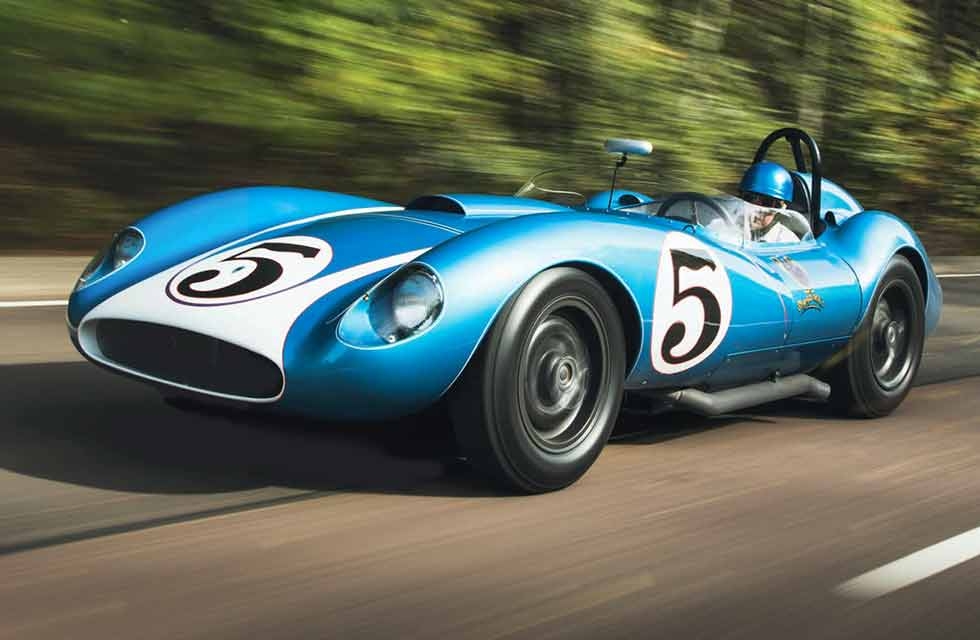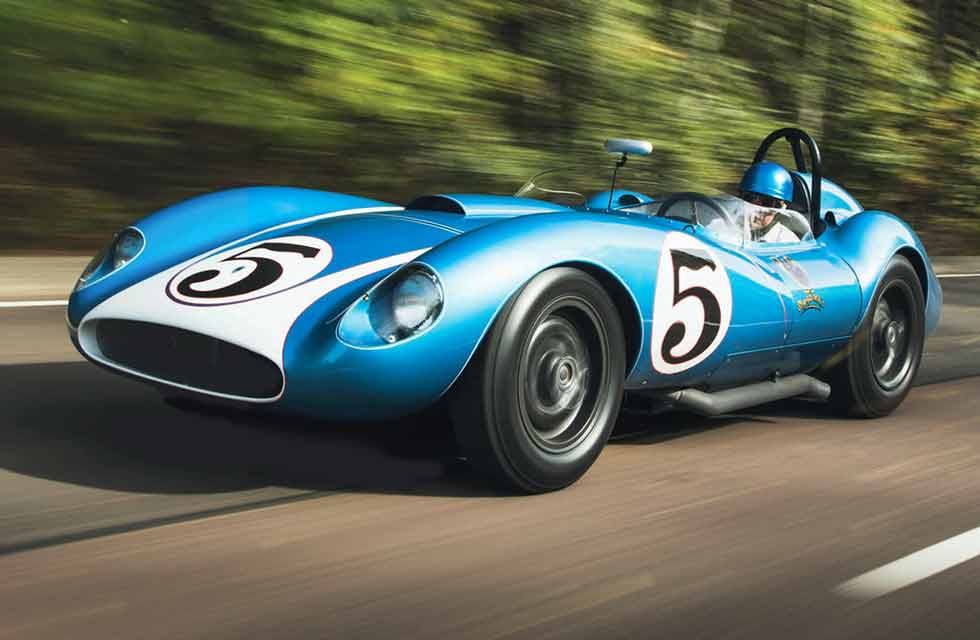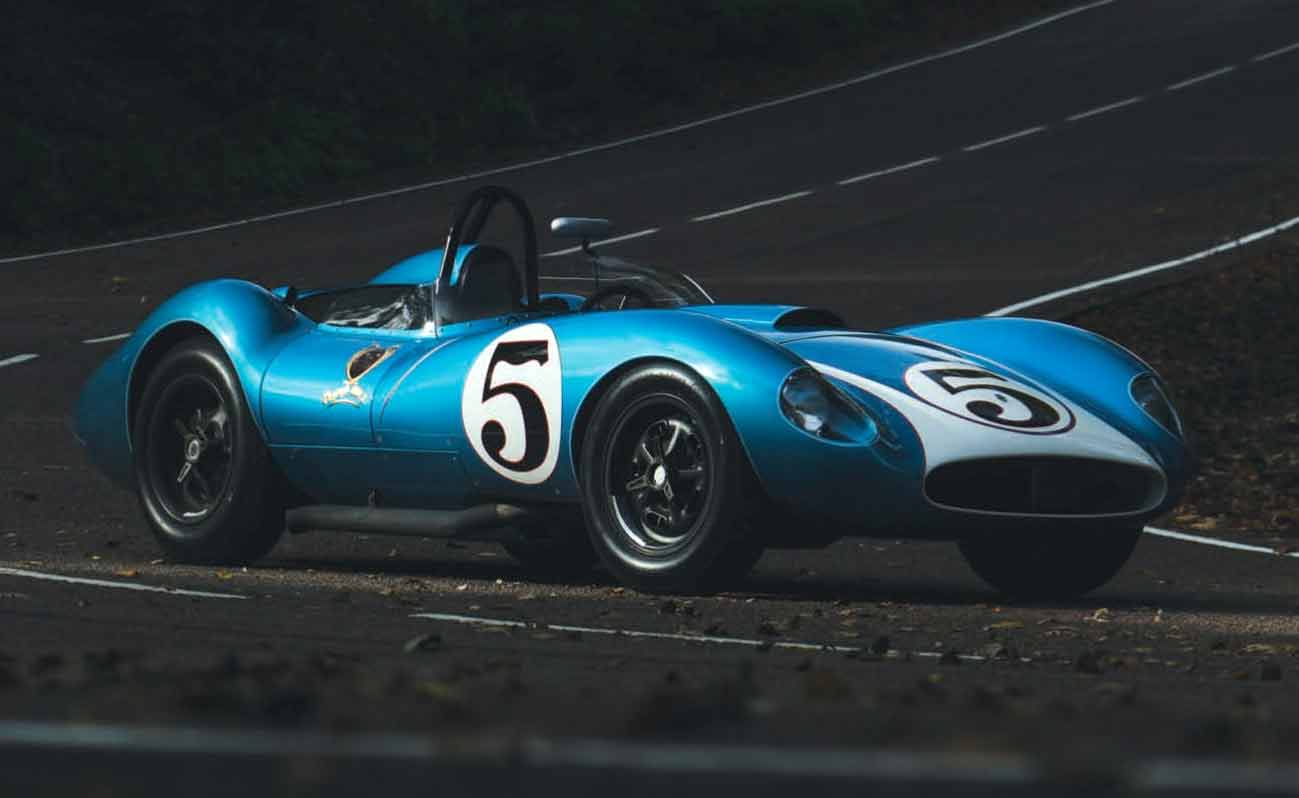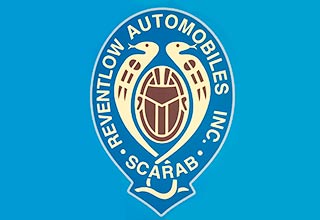
The All American Hero. It took until the end of the ’50s, but with the mighty Scarab, homegrown V8 power finally beat the European elite on US soil. Words Mick Walsh. Photography Luc Lacey.
EXCLUSIVE! SCARAB ROADSTER TRACK TEST
‘You relish clearing the apex to launch this blue beauty again, its forceful charge accompanied by that ear-splitting exhaust’
THE BEETLE THAT ROARED
Motorsport history is full of ‘what if s’. Had the legendary Californian Scarab sports cars arrived in Europe before the FIA’s new 3-litre restriction for the 1958 season, would they have challenged the established order? Frustratingly, even before the first chassis was finished, playboy Lance Reventlow’s racing dream was crushed by the new regulations. The long-held American ambition to win outright ‘across The Pond’ had to wait for the arrival of Henry Ford’s GT40 sortie.

The era of the front-engined ‘big-banger’ sports-racer in World Championship events reached its peak in November 1957 at Caracas, but these spectacular machines – the Ferrari 335 and Maserati 450S, together with a pack of home-brewed specials – raced on in America the following season against Reventlow’s new challenger. The year climaxed with one of the most dramatic races in California, which confirmed the Scarab’s serious potential.
‘You relish clearing the apex to launch this blue beauty again, its forceful charge accompanied by that ear-splitting exhaust’
Once initial development gremlins had been sorted by Reventlow’s talented team, the Chevrolet V8-powered Scarabs became the star attraction on home soil through 1958. The dazzling metallic-blue beauties roared to win after win with ace engineer Chuck Daigh and 21-year-old Reventlow at the wheel. Despite the home dominance, it must have pained Reventlow that his sports-racers never proved their mettle in Europe, where previous Americans – namely Briggs Cunningham – had failed.

Finally, at Riverside on 12 October for the LA Times Grand Prix, his gorgeous Scarabs had a chance to prove they were quicker than the best drivers and most exotic machinery from Europe. Reventlow pulled out all the stops for the premier event, staged at the ultra-fast three-mile track built the previous year in Moreno Valley.
His mechanics worked all hours to prepare three Scarabs – for the boss, Daigh and Bruce Kessler, Reventlow’s old school buddy. Weeks earlier, Kessler had tried a Scarab with a four-cylinder Meyer-Drake Offenhauser motor at Santa Barbara with frustrating results, so the third team car was converted to Chevy power for the big event at Riverside.
The carrot of the $14,500 prize money for the LA Times GP attracted strong interest from Europe to challenge the determined home teams. Overseas favourites included Roy Salvadori’s Aston Martin DBR1 and Jean Behra’s Porsche 718 RSK, but most hotly tipped of the works-prepared teams was returning local boy Phil Hill with the mighty Ferrari 412 MI.

Financed by John von Neumann, the brutish red rocket was powered by the ultimate V12, the four-cam, 415bhp 4.1-litre motor that had powered Luigi Musso to pole around Monza for the Race of Two Worlds, lapping at an awesome 174.67mph. The drag race between Ferrari and Scarab down the mile-long back straight at Riverside was a much-discussed match-up but, unlike Daigh and Reventlow, Hill had never raced at the California circuit.
Among the rival Latin exotics were various other hot-rod Ferraris, including Dan Gurney’s 375 Plus and Masten Gregory’s 410 Sport, while the Temple Buell team enlisted Carroll Shelby to tame its Maserati 450S. The home side was boosted by Max Balchowsky in Old Yeller , Richie Ginther in a 250 Testa Rossa and Bill Krause in a Jaguar D-type.
The high-profile race was further hyped by the local media, with Roy Salvadori stirring up the rivalry by telling the LA Times: ‘American cars weren’t built to survive a race of respectable duration.’ In the days before the big weekend, Reventlow Automotive Inc (RAI) made final tweaks including extra saddle fuel tanks so the Scarabs could run the full distance without stops. The race was run by the United States Auto Club (USAC), more usually associated with the Indy 500, and qualification was staged with cars running solo against the clock. As predicted, the front row turned out to be a Ferrari sandwich, with Daigh’s Scarab taking pole position at 2 mins 4.8 secs to Hill’s best of 2 mins 6 secs, from Reventlow at 2 mins 8.14 secs.
The eager build-up for the event encouraged a huge crowd for Sunday, with close to 100,000 race fans heading in from all over California and causing monster traffic jams. As well as Reventlow’s girlfriend Jill St John, the event attracted other movie stars including David Niven and Peter Ustinov. The desert track really began to bake beneath the high sun and, as spectators struggled with exposure to the 100º heat, the Scarab equipe stayed comparatively cool in the welcome shade of its ex-Maserati team Fiat transporter ahead of the 2pm start.
There’s never been a more exotic front row in California than the muscular Ferrari between the gleaming, sleek Scarabs, and when the green flag finally dropped Daigh launched more quickly than Hill, with Reventlow trailing in third. But as the pack roared through Turn Two, von Neumann’s Ferrari rammed the second Scarab and cannoned it into the ditch. Following his dusty excursion, Reventlow stormed after the pack, the blue racer’s rear bodywork badly crunched and the tank leaking fuel.
While the battle between Daigh and Hill raged ahead, Reventlow was back up to third by lap seven; as Gurney passed the pits, however, he gestured vigorously at the Scarab’s problem and the local favourite was black-flagged. After the tank had been repaired, officials refused to let Kessler, who had taken over his pal’s car, back on to the track, and Reventlow had one of his irate outbursts, which ended in a punch-up.
Back on track, the huge crowd was gripped by the dice for the lead, with Daigh and Hill passing and re-passing. ‘The world could have been falling apart while the Scarab and Ferrari traded places, which they did several times a lap,’ wrote Dean Batchelor in Road & Track. ‘The excitement had everyone around the track standing.’
The exhaust notes of the two battling leaders added to the drama, the V12’s tenor howl contrasting with the V8’s basso profundo. Having never driven the Scarab with a full load of fuel, Daigh had a few alarming moments through the tighter turns, allowing Hill to pass. The Ferrari had the edge down the straight, and Hill set fastest lap early in the race, but Daigh refused to give up and later claimed he “had Phil pretty much in hand”. Despite worries about overheating, Daigh said he, “Kind of played with him a little bit.” For 12 laps the race was relentless and, to Hill’s horror, when the Scarab got close through one turn its wheel spinner marked the Ferrari’s body. “It was nuts – really a saloonbar fight and not the most ethical race-track behaviour,” said Hill. “The Scarabs had been cleaning up on the West Coast and now I had a car they really had to battle with. Although I got ahead, I had to drive my head off to stay there.”
The furious pace couldn’t last in the intense heat, and around lap 20 the Latin V12 started to suffer fuel vaporisation. After running behind Daigh for a few laps, Hill peeled in on lap 24. “The first time I stopped I was so hot I got out of the car, flopped on the pit road and had the mechanics pour a bucket of water over me,” said Hill. After three more stops, the big Ferrari eventually pulled into the pits to retire.
Even with Hill gone, Daigh’s race was by no means easy. Fuel consumption worries, failing brakes and a deafening scream from the damaged differential led to the Scarab’s progress cooling slightly, but Daigh was as determined as ever. When the American came up to lap Salvadori’s Aston, the crew-cut ace couldn’t resist an extra blast. “I just blew his ass off,” smiled Daigh.
Having started to short-shift as the engine began gurgling due to low fuel, a relieved Daigh eventually took the chequer after 203 very hot miles at an 88mph average, with only Gurney’s Ferrari and Krause’s D-type on the same lap. Even Hill was impressed, saying: “That was a big day for American road-racing.” Unfortunately, the press was more focused on Reventlow’s heated scene with officials than the team’s win, but the youthful owner didn’t care. For that weekend his Scarab was on top of the world, and the year ended with further victories at Laguna Seca and Nassau Speed Week to crown the roadster’s final (and only) full season with RAI.
Big-bore sports-racers of the 1950s have long captured my imagination, and the upstart story of the Scarab remains the ultimate: funded by a determined 21-year old and built by Californian hot rodders aided by aviation engineers, it’s a bold contrast with established European exotics.
With Hollywood starlets joining the team trackside, few equipes were more glamorous.
That Riverside victory against the awesome Ferrari 412 MI is legendary, and when I’ve asked American enthusiasts about the greatest race they witnessed, many immediately nominate the ’1958 LA Times GP. No doubt the victory song of the Lance Reventlow Fan Club was sung enthusiastically from the stands: ‘The Prancing Horse forgets to prance, When they see Bruce, or Chuck, or Lance. To Maserati, it’s not so funny, When they are passed by Lance and Money. So weep in England and weep in Italy, When Lance and the Scarab beat you completely.’
To mark the 60th anniversary of that dramatic win, the Pebble Beach Concours d’Elegance organised a Scarab reunion last August, but for me racing cars look wrong sitting silently on a pristine golf course. Riverside is now a housing development and, sadly, few of the team survive, but I’m sure they’d agree that these V8 beauties should be seen and heard running hard. Thankfully, German owner Olivier Ellerbrock feels the same and, after racing his car at the Goodwood Revival, he generously agreed to a dream test run to celebrate Daigh’s historic win.
In contrast to the seductive body, the cockpit is as functional as a dry-lakes record car with aircraft-type buckets, four-spoke Indy roadster-style wheel and a crackle-black dash panel. The black-faced instruments are Stewart Warner, the rev counter alone to the left of the column with the talltale set at 7000rpm. To the right is a cluster of smaller gauges and switches, all identified by Von Dutch’s hand-painted, serif-style capitals for ‘mag’, ‘start’, ‘fan’ and ‘lites’ (sic).
To accommodate its owner’s tall build, specialist Dean Lanzante has fitted a smaller wheel and moved the pedals, but with the original seat it’s still a snug fit between the chassis tubing and gearbox cover. Start-up is a two-handed operation, with your right operating the valve for the fuel while the other flicks the starter. The small-block Chevrolet V8 has an explosive awakening, which one race official in 1958 likened to an artillery barrage at Gettysburg. Just sitting in the cockpit with the stereo rumble from the open exhausts under the sills, it’s easy to conjure the team’s racing dramas, particularly its first flag-to- flag win at Santa Barbara in June ’1958, when it gobbled up Ferraris for lunch. As you push down the accelerator, that raucous burble becomes sharper and louder with menacing volume.
After successfully feeding in the abrupt racing clutch, the Scarab feels Cobra-like to drive. The steering is heavy at first, with limited lock, but once you’re moving it transforms to become both precise and beautifully weighted. The gearbox, a Borg-Warner T10, is worked by a short lever on the left side of the tunnel, topped by an aluminium ball. The action is meaty but surprisingly slick for the power it takes. The ratios are well stacked, but with such mighty torque you barely need to change when up to speed, and owner Ellerbrock says you can pretty much drive Goodwood in top. The clutch and brake pedals are tightly spaced and both have a weighty action, but such pressure gives reassurance.
The V8’s power is remarkable, with relentless punch right through the rev range. I’ve never been one to wear earplugs, even with a period ‘pudding basin’ helmet, and the exhaust roar with the hammer down has dragster noise levels. At Goodwood, marshals rated it the noisiest car as the unsilenced Chevy reverberated around the track. The staggering launch is totally addictive, the surge pinning you against the seat-back in every gear. In 1958, Road & Track timed a Scarab with Reventlow driving and even today the figures are impressive: 0-60mph in 4.2 secs, 0-100mph in 9 secs and a 120mph quarter-mile. Today, with more than 500bhp on tap, it would be even quicker. Daigh reported that the Scarab would pull 170mph down the back straight at Riverside, and Don Orosco was once clocked at 172mph on Goodwood’s Lavant Straight before the valves started to float and he backed off.
Around the deserted test track, with close, wooded perimeters and a rolling middle section, the view ahead, partly distorted by the moulded ’screen, could be Road America, where 18-yearold Jerry Hansen had the mother of all shunts at 125mph in 1962. With such seductive power it would be easy to get carried away, but the car feels on your side. There’s little roll through the corners and the chassis balance inspires an attacking pace, despite the proximity of the trees. Powering over the brows you can feel the car go light, but through the tighter turns the poise is impressive. After a touch of understeer into the bends, you relish clearing the apex to launch this blue beauty again, its forceful charge accompanied by that strident, ear-splitting exhaust.
Straight from the first tests at Goodwood, both Ellerbrock and brother-in-law Christian Gläsel were impressed by the Scarab’s performance. “The engine has so much more power than a D-type and the acceleration is stunning,” says Ellerbrock. “The drum brakes are phenomenal, both strong and precise. Even with all the bodywork off the detail is breathtaking, particularly the rear suspension and inboard brakes.”
Former Scarab owner Orosco lauds the roadster’s remarkable handling: “It’s so well balanced and drifts beautifully. You steer it on the throttle, and I never spun in my years of racing Scarabs. The brakes are better than a Maserati ‘Birdcage’, but the rears have to heat up before you really try. The first time I drove it they spooked me.” Finally getting to drive one of my all-time dream cars lives up to every high expectation. The combination of the sexiest looks of any ’50s sports-racer, connections with so many hero engineers and its magnificent driving character now mesmerises me even more.
Thanks to Olivier Ellerbrock, Dean Lanzante (lanzante.co.uk) and historian Preston Lerner, author of the definitive Scarab history.
TECHNICAL DATA FILE SPECIFICATIONS 1958 SCARAB Mk1
Sold/number built 1958/3 (plus a road car built by Dick Troutman for Reventlow’s half brother in 1985, and the Orosco team’s reconstruction built around original spares)
Construction chrome-moly tubular chassis, aluminium body with removable front and rear
Engine tuned 5.5-litre wet-sump Chevrolet V8, with Racer Brown cam, Scintilla Vertex magneto and Hilborn fuel injection
Max power 577bhp @ 640rpm (on aviation alcohol) / DIN nett
Max torque 370lb ft @ 4500rpm (on aviation alcohol) / DIN nett
Transmission four-speed Borg-Warner T10 manual with aluminium bellhousing, driving rear wheels via a Halibrand quick-change LSD with 3.78:1, 3.30:1 and 3.19:1 ratios
Suspension: front independent, by double wishbones coil springs and Monroe shock absorbers rear de Dion tube, twin parallel trailing arms each side, Watt linkage
Steering Morris Minor rack and pinion
Brakes 11in finned drums, inboard at rear, with bronze-aluminium friction surface
Wheels & tyres Halibrand cast magnesium rims, with 6x16in (f), 7x16in (r) tyres
Wheelbase 7ft 8in (2337mm)
0-60mph 4.2 secs
Top speed 172mph
Below: Daigh and Reventlow in the paddock, with a Lister behind.
Left: Reventlow brought glamour to the pitlane with a succession of celebrity girlfriends – here Jill St John encourages the millionaire ace. Right, from top: Von Dutch pinstriping sets off curvy shape; intake trumpets top Chevy V8. Scarab’s team included top engineers Chuck Daigh, Ken Miles (early chassis work), Phil Remington, Dick Troutman, Tom Barnes, Emil Diedt and Sonny Balcaen. Daigh’s Scarab leads Phil Hill’s Ferrari 412 MI during titanic battle at the ’1958 LA Times GP. From top: workmanlike dashboard is fronted by Indy roadster-style wheel – quick-release Porsche fusebox mounted on far right; distinctive logo adorns Scarab fan Walsh’s ‘pudding basin’ helmet. Scarab shape melds beauty with aggression. Left: the ambitious Lance Reventlow sits in the first Scarab roadster during tests at Willow Springs – note the newly acquired ex-Maserati transporter.
SCARAB ROADSTER: DID YOU KNOW?
Lance Reventlow’s mother, Barbara Hutton, was one of the wealthiest women in the world thanks to her Woolworth fortune, while his aristocratic father was the Danish Count Kurt von Haugwitz Reventlow. Born in London, Lance soon relocated to America for prep school in Phoenix after his mother secured custody following an acrimonious divorce. Reports state that on his 21st birthday his inheritance was $25million, which provided major funding for the Scarab team.

As well as his racing pursuits – which started in 1955, aged just 19, with a Mercedes-Benz 300SL W198 ‘Gullwing’ – Reventlow’s playboy lifestyle included polo, skiing, a spectacular Modernist home in the Hollywood Hills and a succession of gorgeous celebrity girlfriends, among them Natalie Wood, Jill St John and Cheryl Holdridge. After the closure of RAI, he had the first Scarab (chassis 001) converted for street use.
Reventlow died in 1972, at 36, in a Cessna 206 flown by a student pilot, after crash-landing in a box canyon en route to buying property in Aspen.
- The Scarab’s spectacular colour scheme is credited to the offbeat hot-rod artisan Kenneth Robert Howard, better known as Von Dutch, who also detailed James Dean’s Porsche 550 Spyder and Steve McQueen’s Jaguar XKSS. When the body styling was finally resolved, Von Dutch was enlisted to mix up the signature blue metallic paint, which he set off with bold white scallops and distinctive pinstriping. Working after hours, he would arrive with beers and paint through the night. When the crew arrived the next morning, the shop would be a mess but when they peeled back the masking, the body finish looked stunning. Each Scarab was individually painted and the details, particularly the striping, varied from car to car.
- Reventlow had a unique sense of humour, which the distinctive team badge highlights. Designed by Von Dutch, the logo centres around an Egyptian dung beetle known as the Scarab, encircled by two sinister-looking snakes. Theories for the choice vary from the beetle’s symbolism for immortality to, more likely, an in-joke mocking the stallions, big cats and tridents of European marques. The team was also known as ‘Ecurie Flat Cat’.
- The sensational styling of the Scarab roadster is credited to Chuck Pelly, an 18-year-old automotive design student at the ArtCenter College of Design in Pasadena. Pelly had taken summer jobs at Kurtis-Kraft, and was suggested by the specialist. Just one sketch was drawn before plywood formers were made for Emil Deidt to hammer out the body panels. Influences ranged from the Aston Martin DBR1 to Bonneville streamliners, claimed Pelly. After Kessler crashed the first Scarab at Riverside, Reventlow – who had never liked the original shape – got the chance to revise the styling with a leaner nose, head fairing, and more muscular tail. Pelly went on to become a respected industrial designer, with credits including the Porsche 910, Cattiva catamaran, Disney monorail, Samsonite furniture and various BMWs with his company Designworks USA.
- The longest owner of a Scarab roadster was Milwaukee racing legend Augie Pabst. After joining the Meister Brauser team in 1959, he raced the Scarab successfully through to its final victory at Continental Divide Raceways in 1963. Pabst always loved driving the Scarab and eventually bought chassis 002 in 1977, competing regularly in historic events for the next 40 years before selling it to John Mozart.






